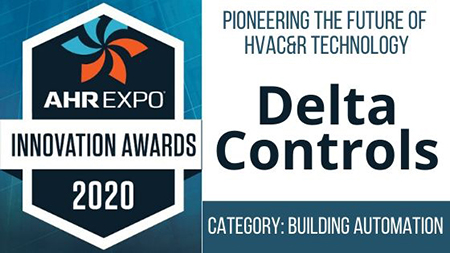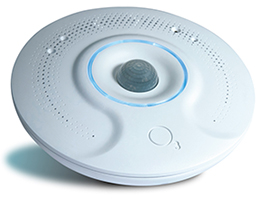

Keeping the Lights on in Occupied Conference Rooms
Two is better than one. Seven is better than two. Delta Controls Inc.’s (Booth 1161) O3 Sensor Hub 2.0—the winner of the 2020 AHR Expo Innovation Awards’ building automation category—combines seven different sensors to provide the most accurate view of an interior space available on the market.
Delta Controls designed the O3 Sensor Hub to provide an enhanced occupancy experience, so that occupants would not have to make small concessions to accommodate the limits of building technology such as waving their arms to turn the lights back on in conference rooms, said Shane Murphy, marketing manager for Delta Controls.
Developed for commercial, office, healthcare, or hospitality environments, “the O3 is designed to affect everyone in a building,” by creating a more comfortable space, having better lighting, reduced operating costs and fewer trouble calls, he said.
Because the O3’s sensors are bundled into one package, it reduces install complexity and cost for building integrators and facilities managers who are seeking retrofit solutions. The integrated sensors provide the most accurate representation of the immediate state of a space, said Murphy.
“The patent-pending composite temperature reading is the fastest and most accurate reading of an occupied area allowing HVAC systems to respond efficiently and optimally,” he said. “HVAC systems are engaged for the exact timeframe in the precise area where the occupant is located.”
The combination of sensors allows the space to respond quickly to ensure it reaches optimal comfort upon occupancy and is deactivated immediately upon vacancy. The ability to provide feedback on the intensity and warmth of natural light allows feedback to tune lighting accordingly.
How Does It Work?
The O3 changes how comfort is measured in a space. Instead of having “wall acne” from multiple devices, the sensor hub is a compact package that provides multiple interfaces making it possible to communicate with and integrate to almost any system, said Murphy.

Delta Controls Inc.’s O3 Sensor Hub 2.0 is bundled into one package and reduces install complexity and cost for building integrators and facilities managers who are seeking retrofit solutions.
The sensor hub reduces install costs, increases temperature and occupancy accuracy, allows for lighting temperature and intensity control and acts as an Internet of Things (IoT) integration portal with standard connectivity and open software interfaces, which makes the Sensor Hub 2.0 easy to connect to and universally accessible.
Typically, building systems rely on wall sensors for temperature and perhaps humidity, and motion sensors are mounted high on the walls in the corner, said Murphy. Only more advanced building systems get access to light temperature and intensity sensors, he said.
“We started by moving our vantage point in the room,” said Murphy. “We packed all of those sensors and more into one device and moved it to the center of the room, mounted to the ceiling.”
He said these sensors combine into one unit to provide an accurate view of how an occupant feels in their space and allows the systems to match environmental control with their activities.
“The O3 comes with tools that allow you to create different room modes for boardrooms depending on if you’re doing a presentation or having a round table meeting. We can turn on projectors and TVs, dim lighting, automate blinds to control ambient light, and match airflow to the room occupancy,” said Murphy.
The O3 uses sensor fusion to create a more accurate view of a space than what is possible with a conventional building automation system, he said. The hub has a thermistor that shares everything about space temperature that a wall sensor would share.
“We combine that with an IR temp sensor that allows us to read surface temperatures within the space,” he said, adding this allows users to see the ambient temperature and see where the occupant is sitting based on temperature readings. He said this reduces and removes inaccuracies caused by poor wall sensor placement. “Building systems will no longer be forced into cooling modes when office equipment or computers are placed too close to a sensor,” he said.
The O3 changes how occupants are detected in a space and how the system reacts to their presence. The system’s motion detection is one strategy, and the system uses sound sensors to identify occupied sound patterns—such as typing or talking—and then learns what ambient sounds are present to rule out false positives from outside noise or hallway chatter, according to Murphy. The O3 then confirms occupancy by using the IR temp sensor to detect if a human shape is in the room.
“With a motion sensor, systems have to incorporate a timeout period before shutting down lighting or HVAC to minimize the ‘arm waving’ scenario. With O3 Sensor Fusion, we can turn off those systems moments after you leave the room,” said Murphy.
Any system or product can integrate with the sensor’s information, which allows engineers and industry professionals to create custom applications—such as interactive dashboards—and perform big data analysis, which can lead to future innovations in predictive analysis and continuous improvement and optimization in building and HVAC design, he said.
“Sensor data can be accessed by third-party control systems using native BACnet, custom applications and dashboards can be created using Bluetooth, MQTT and REST API’s. Best practices in IoT security have been implemented to ensure conformity to industry standards,” he said.
The Team Behind of the Product
A Delta Controls team of engineers and product developers—with skills in mechanical design, electrical design, instrumentation, machine learning, software architecture, signal processing, network technology, web services, mobile phone application development, building science and more—created the product that leveraged all those skills in one package, said Murphy.
The team was challenged with ensuring the O3 could receive enough processing power without generating so much heat that would throw off sensor readings and deciding which network technologies and platforms the hub should support, said Murphy.
For additional coverage of AHR Expo, visit ASHRAE Journal’s AHR Today web page.